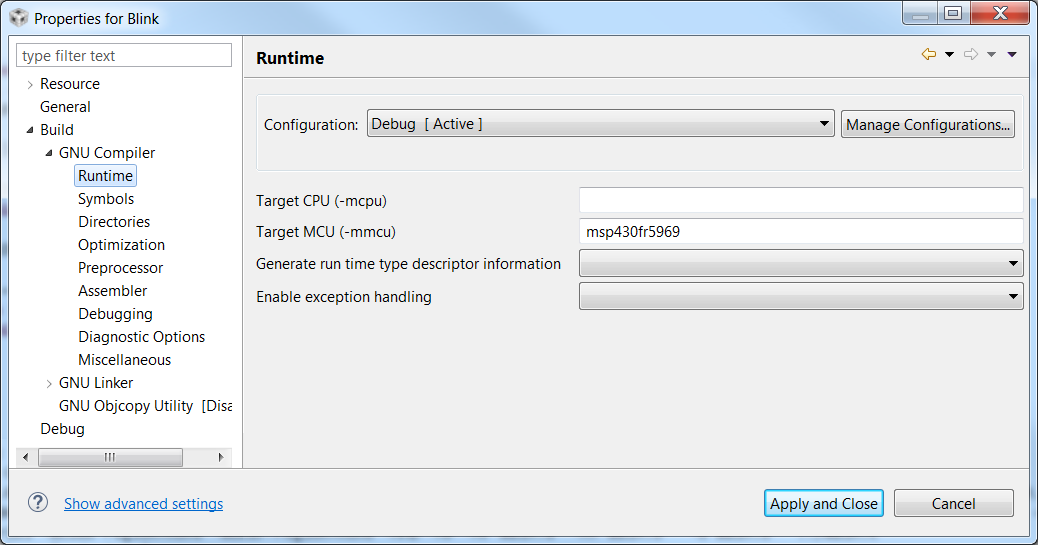SLAU646F September 2015 – June 2020
- Read This First
- 1Introduction
- 2Installing MSP430 GCC Toolchain
-
3Using MSP430 GCC Within CCS
- 3.1 Create New Project
- 3.2 Debug Using MSP-FET, MSPFET430UIF, eZ-FET, eZ430
- 3.3
Build Options for MSP430 GCC
- 3.3.1 GNU Compiler
- 3.3.2 GNU Compiler: Runtime
- 3.3.3 GNU Compiler: Symbols
- 3.3.4 GNU Compiler: Directories
- 3.3.5 GNU Compiler: Optimization
- 3.3.6 GNU Compiler: Preprocessor
- 3.3.7 GNU Compiler: Assembler
- 3.3.8 GNU Compiler: Debugging
- 3.3.9 GNU Compiler: Diagnostic Options
- 3.3.10 GNU Compiler: Miscellaneous
- 3.3.11 GNU Linker
- 3.3.12 GNU Linker: Basic
- 3.3.13 GNU Linker: Libraries
- 3.3.14 GNU Linker: Symbols
- 3.3.15 GNU Linker: Miscellaneous
- 3.3.16 GNU Objcopy Utility
- 3.4 CCS Compared to MSP430 GCC
-
4MSP430 GCC Stand-Alone Package
- 4.1 MSP430 GCC Stand-Alone Package Folder Structure
- 4.2 Package Content
- 4.3 MSP430 GCC Options
- 4.4 MSP430 Built-in Functions
- 4.5 Using MSP430 GCC Support Files
- 4.6 Quick Start: Blink the LED
- 4.7 GDB Settings
- 5MSP430 GCC Features
- 6Building MSP430 GCC From Sources
- 7MSP430 GCC and MSPGCC
- 8Appendix
- 9References
- Revision History
3.3.2 GNU Compiler: Runtime
Figure 3-4 shows the MSP430 GCC Runtime settings window.
 Figure 3-4 MSP430 GCC Settings: Runtime
Figure 3-4 MSP430 GCC Settings: RuntimeTable 3-2 describes the options that are available for MSP430 GCC Runtime settings.
| Option | Description |
|---|---|
| Target CPU (-mcpu) | Specifies the Instruction Set Architecture (ISA) to use. Accepted values are msp430, msp430x, and msp430xv2. This option is deprecated. The '-mmcu=' option should be used to select the ISA. |
| Target MCU (-mmcu) | Select the MCU to target. This is used to create a C preprocessor symbol based on the MCU name, converted to upper case and prefixed and postfixed with__. This in turn is used by the msp430.h header file to select an MCU-specific supplementary header file.
The option also sets the ISA to use. If the MCU name is one that is known to only support the 430 ISA then that is selected, otherwise the 430X ISA is selected. A generic MCU name of msp430 can also be used to select the 430 ISA. Similarly, the generic msp430x MCU name selects the 430X ISA. In addition, an MCU-specific linker script is added to the linker command line. The script's name is the name of the MCU with ".ld" appended. Thus, specifying '-mmcu=xxx' on the gcc command line defines the C preprocessor symbol __XXX__ and causes the linker to search for a script called 'xxx.ld'. This option is also passed to the assembler. |
| Generate run time type descriptor information | Enable or disable generation of information about every class with virtual functions for use by the C++ runtime type identification features.
|
| Enable exception handling | Enable or disable exception handling. Generates extra code needed to propagate exceptions.
|